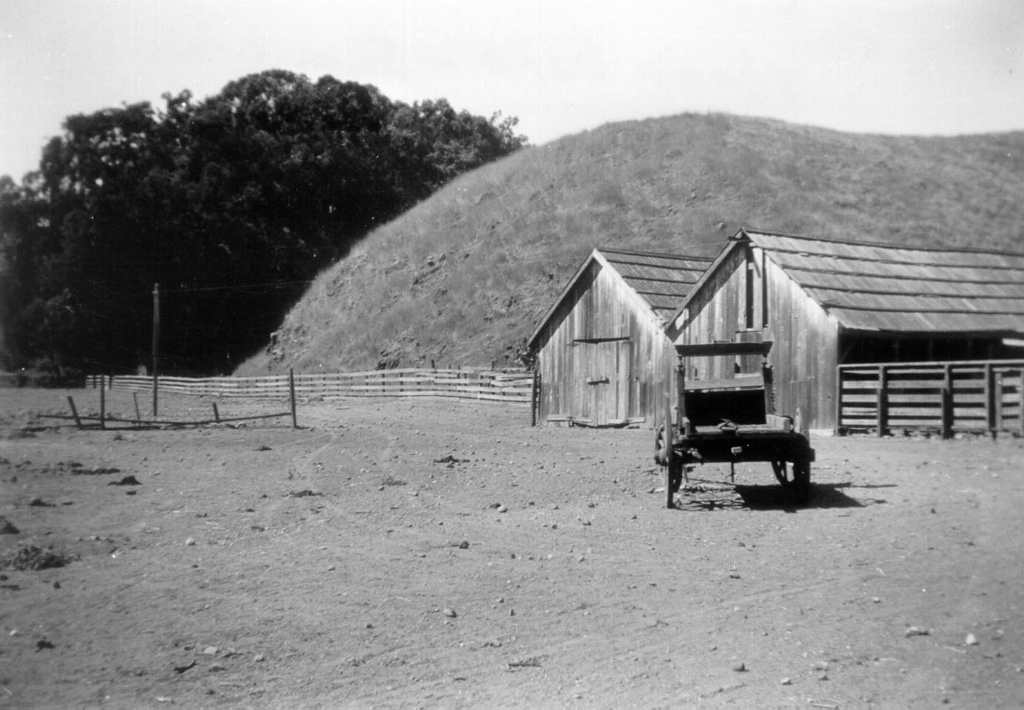
Shearing was Scorpion's Biggest Operation
Every year, thousands of sheep were sheared in the shed that once stood right here.
Shearing season was the liveliest time of year for the ranch. In the early years of ranching, more than 60 temporary workers arrived for the six-week spring (and sometimes fall) shearing season. Humming with life, you'd hear the snip snip of shears, sheep bleating in the pens, and snatches of song but little talking as the shearers tackled the job of flipping sheep on their backs, shaving them, and stuffing sacks with wool.
Packing Scaffold
All that remains today is the packing scaffold to the right of the kayak concession buildings. After a shearer clipped a sheep, a ranch hand tied the fleece into a bundle and threw it up to a sacker. The sacker threw it into a long burlap sack hanging from a scaffold. He then stepped down into the sack, hanging onto a rope for support, and stomped the fleeces down. When a sack was full, the end was tied with curved needle and heavy thread. Full sacks weighed 300-400 pounds.
Shearers
Workers days were filled with backbreaking, physical work, but shearers were paid for every sheep they sheared. The faster they worked, the higher the wage. A good shearer could clip 100 or more fleeces a day.
Some years were better than others. The number of sheep sheared depended on how many could be rounded up. Sometimes drought reduced the size of the flock too. Usually, the shearers at Scorpion clipped between 3,500 and 5,000 sheep annually. Island-wide, the most sheep sheared in a year was over 50,000 in 1890 - enough to make 88,000 sweaters.
It was a Long, Rough Route to Market
The work didn't end once shearing was finished. Getting livestock and wool to markets on the mainland was difficult, but essential for a successful business. Sea transport was unreliable - unpredictable weather made transport dangerous and difficult to schedule. The risks were great and the costs high - livestock, cargo and human lives were lost to the sea.
Even loading goods was a challenge. Before the pier was built, all goods, including skittish livestock, were wrestled from the rocky beach onto shaky skiffs or rafts. These small craft transported the goods to larger ships anchored in the harbor. Building the pier helped, but it didn't solve all the loading problems - in 1959, the wooden pier collapsed from the weight of heavy wool bales.
Out on the Range
Rounding up the island's wild sheep was tough, exciting, and crucial to the ranch's success.
The Santa Cruz Island Company treated its sheep differently than most mainland ranches. Instead of being herded, the sheep roamed freely in vast pastures. They ventured into steep canyons and up inaccessible mountainsides. The sheep were not used to being herded. These conditions forced traditions from early California to continue on Santa Cruz Island - tough cowboys (vaqueros) combed the rough terrain on horseback to round up the lively sheep.
When the Gherinis took over the east end in 1926, they built an elaborate fencing system to enclose the range. This improved the quality of pastureland and made it easier to control the sheep. Some sheep still ran wild in the hills, however. The vaqueros never caught them all; many of the island sheep escaped being sheared their whole lives.
For three generations vaqueros have been riding on the island. Every spring they come for the yearly round of sheep, called from earlier times corrida. Most of them are barbarenos, born in or near Santa Barbara... the vaquero's get-up consists of a blue shirt and jeans, a knife stuck in his belt in a leather sheath, a worn old hat,not a fancy sombrero. He knots a red or blue cotton bandana around his neck. The vaquero's tools are a good horse and a reata, a rawhide lariat coiled and tied near the saddle horn. -Helen Caire
Is there something we missed for this itinerary?
Itineraries across USA


















































